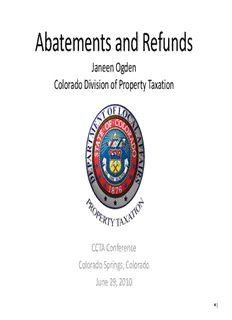
The Abatement Process - Colorado County Treasurers' and Public PDF
Preview The Abatement Process - Colorado County Treasurers' and Public
Abatements and Refunds Janeen Ogden Colorado Division of Property Taxation CCTA Conference Colorado Springs, Colorado June 29, 2010 1 Abatements & Refunds • Definitions • Need for Abatements • History of Abatement Law • Abatement Process • Treasurer’s Role in Processing • Abatement Situations • Treasurer’s Abatement Reports 2 Definitions • Refund: Return taxes already paid • Abate: Cancel or reduce tax owed 3 Need for Abatements • Due Process – Guaranteed by U.S. & Colo. Constitutions – No one deprived of life, liberty, or property – Opportunity to challenge legality of action 4 Due Process • Challenge assessment through abatement process after taxes are levied • Taxpayer has “right” to file abatement petition • Taxpayer presents evidence of incorrect value or tax 5 Need for Abatements • To change tax amounts after the tax roll is delivered to the Treasurer • Treasurers and assessors are required by statute to report to the commissioners any erroneous or illegal taxes, due to: – Erroneous assessments – Irregularities in levying – Clerical errors – Overvaluations 39-10-114(1)(a)(I)(A) 6 History of Abatement Law • Procedures created in 1902 • Before 1982, no limit on number of years • 1981 (SB 167) added limit of 6 years • 1988 (SB 184) changed limit to 1 year beginning in 1990 • 1991 (SB 231) established 2-year limit 7 Abatement Process • Abatement process usually starts in assessor’s office • Who can initiate abatements? – Treasurer by statute – Assessor was added in 1996 – Taxpayer or Agent -- most common • Taxpayer must have proper “standing” to legally file for an abatement… 8 Legal Standing (Right to make a claim) • Ownership • Agent for taxpayer • Ownership through foreclosure • Lessee (with authorization in lease) Note: Tax lien certificate holders do not have standing until Treasurer’s Deed is issued. 9 Legal Standing • Keep in mind that anyone can “file” an abatement petition, but if the petitioner does not have standing, the petition may be denied. 10
Description: